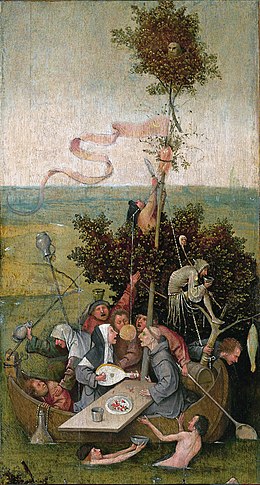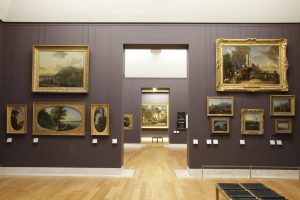Ah, the Renaissance… The Sistine Chapel painted by Michelangelo, Mona Lisa’s portrait by Da Vinci, the paintings by Raphaël… Too often, we only think of Italy when it comes to the great artworks of the 1400s and 1500s. But in the Netherlands, these centuries also brought forward what is often called the Dutch or Flemish Renaissance.
We were lucky to recently follow a tour led by our guide Victor (see our post about it here). This article is a quick summary of what he had to show & say about the early Flemish & Dutch masters.
We hope that this article gives you yet another reason to go to the Louvre to admire those paintings.

Van Eyck, Madonna of Chancellor Rollin
Two characters face each other in this painting. On the right, the Virgin Mary (or Madonna), who is holding an infant Jesus Christ. On the left, Chancellor Rollin, the patron of this painting. An angel floats above and crowns Mary. Outside of the room, there is a balcony, from which two other characters observe the landscape in the distance. The landscape itself features a city with two banks separated by a river on which we can see an island.
The painting might look a little odd at first. But there is an explanation for the fact that the Virgin Mary is in the same room than Chancellor Rollin. If you pay attention to his gesture, you’ll notice he’s on his knees praying. His prayer book is open in front of him. Which leads to this interpretation : through his prayer, Chancellor Rollin is connecting with the Virgin Mary. Hence the fact Van Eyck paints him in front of her and has the same size in the painting.
Van Eyck made the painting around 1435 for Nicolas Rolin (c. 1376/80-1462), chancellor of Philippe the Good. It was intended to decorate the Saint-Sebastian chapel he decided to built in 1426-1428 in the church Notre-Dame-du-Châtel in Autun. The men of the French Revolution unfortunately destroyed the church in 1793. The Louvre Museum acquired the painting a couple of years later, in 1800. It’s where you can still admire it today, in room 818, on the second floor of the Richelieu Wing.

Metsys, The Money Changer and His Wife
The money changer, on the left, is carefully weighing money, while a customer, whose reflection is visiblein the mirror in the foreground, waits. The woman on the right, who is probably the money changer’s wife, looks away from the religious book she was reading (we can a reverse image of a Virgin and Child) to watch her husband working. In the background of the painting, on the right, the door is open and shows two characters interacting on the street.
Although this painting might look like a simple scene depicting daily life 5 centuries ago, there is more to it than meets the eye. The woman might looks like she’s approving what her husband does, but it could also mean her greed distracts her from her religious studies. As a whole, it looks like Metsys is trying to comment on the fact that his society is moving from a religious mentality to a capitalist mentality, with new commercial and materialistic ideals.
Behind the couple in the foreground, Metsys disposes a number of objects, seemingly without any order . Some of them are easily identifiable as metaphorical, like the apple, symbol of temptation, or the blown out candle, which can symbolize the end of the life. There are many more details to see of course, and to do so, you’ll have to go to room 814 of the Louvre, on the second floor of the Richelieu Wing.

Bosch, Ship of Fools
A group of ten characters are gathered on a small boat. In the center, a franciscan monk, a nun and three other characters are trying to eat a crepe without using their hands. To the left, a woman is about to hit a man with a jug. On the opposite of the diagonal, a man dressed like a fool is calmy drinking from a cup. In the center, a man is climbing a mat to grab a type of poultry hanging from the top. Finally, the ship seems to be slowly drifting away, without any kind of directions.
The painting is generally seen as a commentary on general madness. Everybody on the ship is foolish enough to be on a boat without sail or helm. Actually, the only one that looks normal is the character dressed up as a fool… The ship also bears the flag of the infidels, as the pink banner seems to have a moon crescent, symbol of islam ; back then, it symbolized the madness of disbelievers, or those who believed in the wrong God.
The painting was actually once part of the Drifter Triptych, with the Death and the Miser (National Gallery of Art, Washington) and Allegory of Gluttony and Lust (Yale University Art Gallery, New Haven). the central panel is unfortunately missing. The reverse of the painting displays The Wayfarer (Museum Boijmans Van Beuningen, Rotterdam). The Louvre Museum was given the Ship of Fools by one of its own curators, Camille Benoît, in 1918. It is today on display in room 815, Richelieu Wing, second floor.

Dürer, Portrait of the Artist Holding a Thistle
The painter, aged 22, displays himself holding a thistle, symbol of love and faithfulness, in Strasbourg, where he stayed in 1493. This painting might have been an engagement portrait, since he married Agnes Frey soon later, on July 7, 1494. However, next to the date, on the top of the painting, Dürer writes in German : “My affairs follow the course allotted to them on high”, meaning the painting could be a reference to the Passion of Christ.
In any case, this painting is one of the first independent self-portraits of Western art. Indeed, since the end of the Middle Ages, painters had the habit of painting themselves in their paintings, and they were usually noticeable because of the fact that they would look directly at the viewer. However, these self-portraits were usually secondary in the painting, whose subject was most of the time religious. Hence the celebrity of this first independant self-portrait.
The painting was acquired by the Louvre Museum in 1922 after being part of the collection owned by Nicolas de Villeroy, whose possessions were confiscated after the Treaty of Versailles of 1919 that followeds the First World War, since the owner had chosen German citizenship a few years back (despite the fact Villeroy had intended to donate it to the Louvre anyway). You can see it in room 809, on the second floor of the Richelieu Wing.

Cranach the Elder, The Three Graces
The Three Graces were a group of characters of Greek mythology, goddesses of charm, beauty and creativity. They were the daughters of Dionysos (god of wine) and Aphrodite (goddess of love and beauty). They are always shown together. Their names are Thalia (goddess of festivity and rich banquets), Aglaea (goddess of beauty & splendor), and Euphrosyne (goddess of good cheer, joy and mirth). They are more often than not shown naked or barely clothed.
Lucas Cranach was known as the most prominant painter of the ideas of Martin Luther and the protestant Reformation, so it is a rather surpising subject for him to tackle. But precisely, this painting has to be seen in a sense of moral & christian elevation, the three Graces being here to encourage the viewer to be more generous and to have more love for others. There is also a bit of humor here, in the fact that one of the three graces wears a contemporary hat.
The painting is visible in room 810, second of the Richelieu Wing. It was recently acquired by the Louvre Museum, thanks to a crowd-funding campaign that managed to raise over 4 million euros.
We hope this article made you want to come with us to see the Flemish Renaissance masterpieces the Louvre has to offer. If that’s the case, book your tour here !
Article written by Lucien




